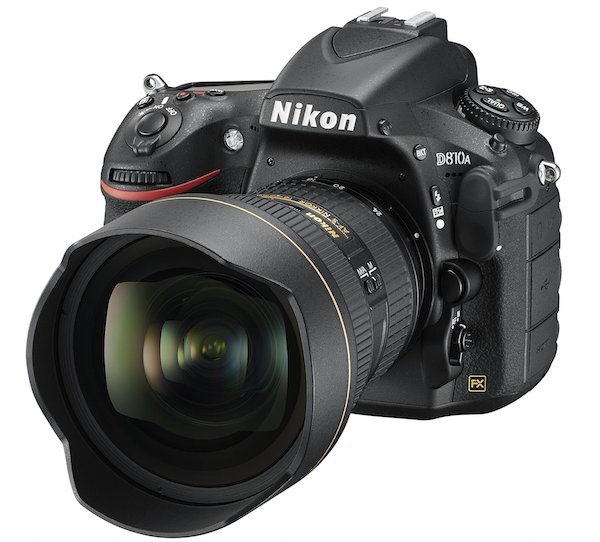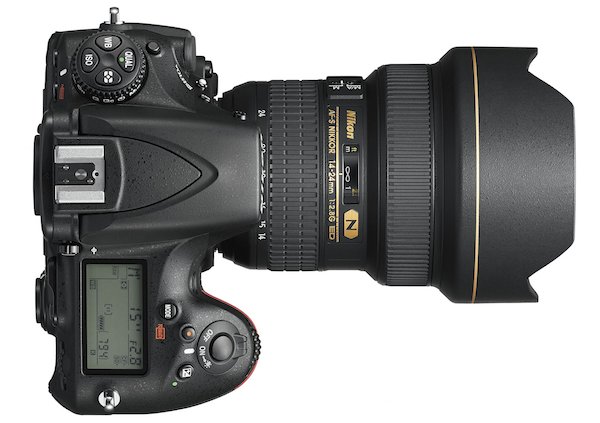Nikon D810A is Highest-resolution Astrophotography DSLR
A specially designed filter lets this 36MP camera capture the vibrant reds for better images of the night sky.

Astrophotographers, experienced and novice alike, now have a fresh option for capturing images of the cosmos. Nikon's new D810A ($3,800) is a modified version of its full-frame D810 sibling and is designed specifically to record deep space sites such as nebulae and distant galaxies either with Nikon's AF-S or AF lenses or with a telescope connected via a third party adapter. The camera is slated to ship in late May.
MORE: Nikon D810 Pro DSLR Review
Here's how it works: The D810A’s infrared (IR) cut filter has been modified to allow the H-alpha (Hydrogen-alpha) wavelength to pass through to the sensor. By doing so, the D810A captures a more intense red from heavenly bodies that emit the 656nm wavelength of light. Nikon claims that the D810A provides four times more sensitivity to the 656nm spectral line than the D810, which is good news for night sky photographers. Because of the special filter, however, the D810A should probably stay pointed at the night sky, since color reproduction for general photography won’t be as accurate as the D810's. This is particularly true for reds, blues and purples.
Nikon has equipped the D810A with other features to make astrophotography a little easier. The camera has a new Long Exposure Manual Mode so you can set shutter speeds ranging from 4 seconds to 900 seconds (15 minutes). Bulb is also available, which keeps the shutter open as long as the button is depressed. Signal-to-noise ratio has been enhanced to deliver better low light/high ISO performance within the camera’s native ISO range of 200-12,800, which is expandable by three f-stops to ISO 100, 25,600 and 51,200. To complement the D810A, Nikon’s free Capture NX-D image-processing software will include a new Astro Noise Reduction feature.

A Virtual Exposure Preview Mode, which simulates a 30-second exposure in Live View with a brighter preview image, provides the ability to more accurately compose and focus. And, a red-light virtual horizon indicator won’t interfere with your ability to see at night once your eyes have adjusted to the darkness.
Astrophotography can be challenging, but the D810A makes capturing those distant, natural phenomena in the skies a little less daunting. This is, as far as we know, Nikon’s first foray into astrophotography. Canon has had a couple of cameras, most recently the 60Da launched in 2012, designed specifically for astrophotography. But the 60Da is built around an APS-C sized sensor. With Nikon’s full-frame, 36-megapixel sensor, newer technology and improved light sensitivity, we think that the D810A will certainly cause a stir in the astrophotography community and beyond.
Key Specifications
Model: Nikon D810A
Megapixels: 36.3
Type: full-frame DSLR
Price: TBD
Shooting speed: 5fps
Sensor type: CMOS
AF points: 9, 21 and 51 options
Shutter speed range: 1/8000 to 30 sec, Bulb (unlimited), long-exposure manual mode from 4 to 900 sec
ISO range: 200-12,800 (expandable to low 100; high 51,200 equivalents)
Main video resolutions/frame rates: 1920 x 1080 at 60, 50, 30, 25, 24 fps; 1280 x 720 at 60, 50 fps
Video file format: MOV
Built-in Flash: Yes
Hot shoe: Yes
LCD: 3.2 inches
Card type: CompactFlash and SD/SDHC/SDXC slots
Ports: Audio in, HDMI output, headphone connector, USB 3.0
Shots per charge: 1200
Wireless capabilities: Eye-Fi compatible; optional wireless transmitter WT-4A; UT-1 communication unit + WT-5A
Image stabilization: lens-dependent
Size/Weight: 5.8 x 4.9 x 3.3 inches; 1 lb 15.1 ounces (body only)
Sign up to get the BEST of Tom's Guide direct to your inbox.
Get instant access to breaking news, the hottest reviews, great deals and helpful tips.
- Best DSLRs – Beginner to Pro
- Best Mirrorless Cameras
- Andromeda Galaxy Glitters in Spectacular Photo by Astrophotographer
Writer and photographer Theano Nikitas has been covering photography for almost 20 years and has reviewed hundreds of digital cameras as well as other digital imaging hardware and software. Follow her @TNikitas1 and on Google+. Follow us @TomsGuide, on Facebook and on Google+.
Theano Nikitas is a freelance journalist and photographer. She's been writing about photography for more than 20 years, contributing countless reviews of cameras, lenses, accessories and software packages to Tom's Guide. Her work has also appeared in dozens of other magazines and websites, including CNET, DPreview, PopPhoto, Professional Photographer and Shutterbug.
